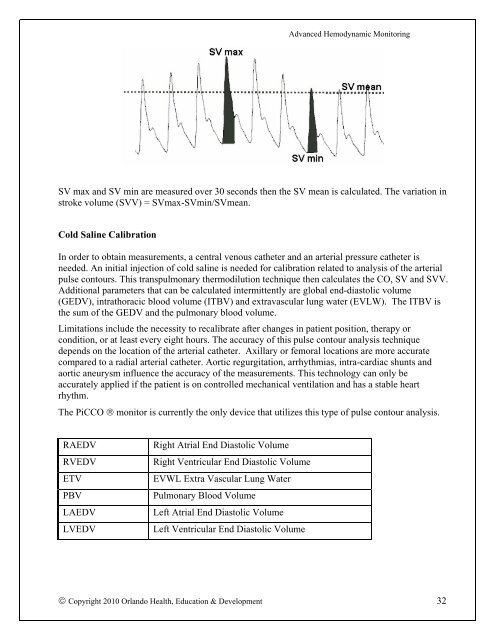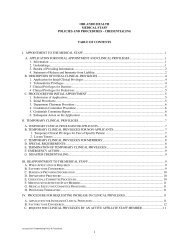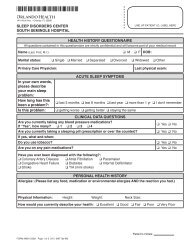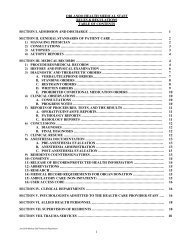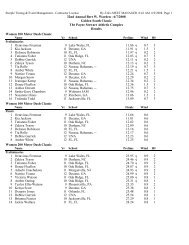Advanced Hemodynamics - Orlando Health
Advanced Hemodynamics - Orlando Health
Advanced Hemodynamics - Orlando Health
Create successful ePaper yourself
Turn your PDF publications into a flip-book with our unique Google optimized e-Paper software.
<strong>Advanced</strong> Hemodynamic Monitoring<br />
SV max and SV min are measured over 30 seconds then the SV mean is calculated. The variation in<br />
stroke volume (SVV) = SVmax-SVmin/SVmean.<br />
Cold Saline Calibration<br />
In order to obtain measurements, a central venous catheter and an arterial pressure catheter is<br />
needed. An initial injection of cold saline is needed for calibration related to analysis of the arterial<br />
pulse contours. This transpulmonary thermodilution technique then calculates the CO, SV and SVV.<br />
Additional parameters that can be calculated intermittently are global end-diastolic volume<br />
(GEDV), intrathoracic blood volume (ITBV) and extravascular lung water (EVLW). The ITBV is<br />
the sum of the GEDV and the pulmonary blood volume.<br />
Limitations include the necessity to recalibrate after changes in patient position, therapy or<br />
condition, or at least every eight hours. The accuracy of this pulse contour analysis technique<br />
depends on the location of the arterial catheter. Axillary or femoral locations are more accurate<br />
compared to a radial arterial catheter. Aortic regurgitation, arrhythmias, intra-cardiac shunts and<br />
aortic aneurysm influence the accuracy of the measurements. This technology can only be<br />
accurately applied if the patient is on controlled mechanical ventilation and has a stable heart<br />
rhythm.<br />
The PiCCO monitor is currently the only device that utilizes this type of pulse contour analysis.<br />
RAEDV<br />
RVEDV<br />
ETV<br />
PBV<br />
LAEDV<br />
LVEDV<br />
Right Atrial End Diastolic Volume<br />
Right Ventricular End Diastolic Volume<br />
EVWL Extra Vascular Lung Water<br />
Pulmonary Blood Volume<br />
Left Atrial End Diastolic Volume<br />
Left Ventricular End Diastolic Volume<br />
Copyright 2010 <strong>Orlando</strong> <strong>Health</strong>, Education & Development 32


